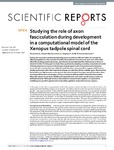Studying the role of axon fasciculation during development in a computational model of the Xenopus tadpole spinal cord
| dc.contributor.author | Davis, O | |
| dc.contributor.author | Merrison-Hort, R | |
| dc.contributor.author | Soffe, SR | |
| dc.contributor.author | Borisyuk, R | |
| dc.date.accessioned | 2018-03-27T10:16:46Z | |
| dc.date.issued | 2017-10-19 | |
| dc.identifier.issn | 2045-2322 | |
| dc.identifier.issn | 2045-2322 | |
| dc.identifier.other | ARTN 13551 | |
| dc.identifier.uri | http://hdl.handle.net/10026.1/11178 | |
| dc.description.abstract |
During nervous system development growing axons can interact with each other, for example by adhering together in order to produce bundles (fasciculation). How does such axon-axon interaction affect the resulting axonal trajectories, and what are the possible benefits of this process in terms of network function? In this paper we study these questions by adapting an existing computational model of the development of neurons in the Xenopus tadpole spinal cord to include interactions between axons. We demonstrate that even relatively weak attraction causes bundles to appear, while if axons weakly repulse each other their trajectories diverge such that they fill the available space. We show how fasciculation can help to ensure axons grow in the correct location for proper network formation when normal growth barriers contain gaps, and use a functional spiking model to show that fasciculation allows the network to generate reliable swimming behaviour even when overall synapse counts are artificially lowered. Although we study fasciculation in one particular organism, our approach to modelling axon growth is general and can be widely applied to study other nervous systems. | |
| dc.format.extent | 13551- | |
| dc.format.medium | Electronic | |
| dc.language | en | |
| dc.language.iso | en | |
| dc.publisher | Nature Publishing Group | |
| dc.subject | Animals | |
| dc.subject | Axon Fasciculation | |
| dc.subject | Larva | |
| dc.subject | Models, Biological | |
| dc.subject | Spinal Cord | |
| dc.subject | Synapses | |
| dc.subject | Xenopus laevis | |
| dc.title | Studying the role of axon fasciculation during development in a computational model of the Xenopus tadpole spinal cord | |
| dc.type | journal-article | |
| dc.type | Article | |
| plymouth.author-url | http://gateway.webofknowledge.com/gateway/Gateway.cgi?GWVersion=2&SrcApp=PARTNER_APP&SrcAuth=LinksAMR&KeyUT=WOS:000413190900030&DestLinkType=FullRecord&DestApp=ALL_WOS&UsrCustomerID=11bb513d99f797142bcfeffcc58ea008 | |
| plymouth.issue | 1 | |
| plymouth.volume | 7 | |
| plymouth.publication-status | Published | |
| plymouth.journal | Scientific Reports | |
| dc.identifier.doi | 10.1038/s41598-017-13804-3 | |
| plymouth.organisational-group | /Plymouth | |
| plymouth.organisational-group | /Plymouth/Faculty of Science and Engineering | |
| plymouth.organisational-group | /Plymouth/REF 2021 Researchers by UoA | |
| plymouth.organisational-group | /Plymouth/REF 2021 Researchers by UoA/UoA11 Computer Science and Informatics | |
| plymouth.organisational-group | /Plymouth/Users by role | |
| plymouth.organisational-group | /Plymouth/Users by role/Researchers in ResearchFish submission | |
| dc.publisher.place | England | |
| dcterms.dateAccepted | 2017-10-03 | |
| dc.identifier.eissn | 2045-2322 | |
| dc.rights.embargoperiod | Not known | |
| rioxxterms.versionofrecord | 10.1038/s41598-017-13804-3 | |
| rioxxterms.licenseref.uri | http://www.rioxx.net/licenses/all-rights-reserved | |
| rioxxterms.licenseref.startdate | 2017-10-19 | |
| rioxxterms.type | Journal Article/Review | |
| plymouth.funder | Cross-modality integration of sensory signals leading to initiation of locomotion::BBSRC | |
| plymouth.funder | Cross-modality integration of sensory signals leading to initiation of locomotion::BBSRC | |
| plymouth.funder | Cross-modality integration of sensory signals leading to initiation of locomotion::BBSRC |


